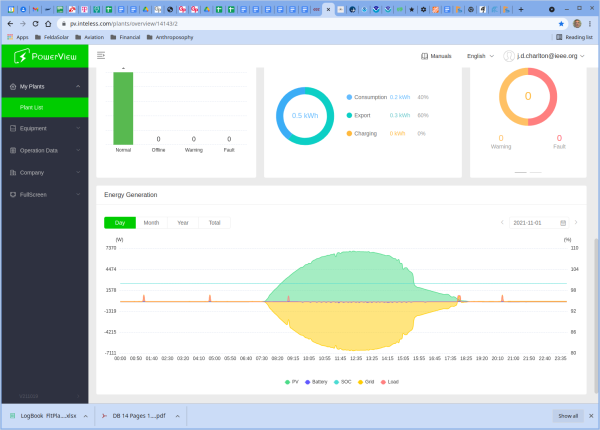The above diagram shows the fully functioning grid sell PV inverter operation for one full day (11-1-21). This was a sunny day so there is not much up/down fluctuation during the day. The small orange blips are when a well pump comes on. The well pumps are powered only by the solar inverter. Everything else is powered by the grid in the normal grid connected mode. The green is the PV power generated and the grid power is yellow which shows that the power is mostly going to the grid. In our configuration, the grid power is also powering our house and shop so some of the power going to the grid is used locally by our shop and house.
We powered up the system in stages:
- We used a circuit breaker in our house supply panel to back power the house with the solar inverter.
- Next connected the inverter grid output to the power grid meter panel.
- Next we installed a transfer switch which allows transferring the power source to the solar inverter only. This is needed when the grid power is down for an alternate power source.
- Get the final inspection for the solar power installation permit.
- Get the power company to change the meter to allow selling power to the grid.
In stage 1 we were able to power the house including AC and well pumps with the solar power alone during the day. The house uses about 2 KW average with up to 10 KW or more when hot water heater and other appliances are active. For AC, we have a variable load compressor which reduces the start-up power required.
Stage 2 was to connect the solar inverter to the grid and test grid sell mode. This is a matter of following the Sol-Ark inverter manual and the inverter is designed to send power to the grid when it is producing more power than we are using.
Stage 3 was mainly rewiring the meter panel to go to one side of the transfer switch and the solar inverter to go to the other side. Since our solar inverter is limited to 60 Amps, and the grid panel is 200 Amps, we are not able to run everything when we are only using the solar panel and battery power. So we have to turn off breakers in the panel that can overload the solar inverter. Still 60 Amps is enough to provide power for most of our needs. We did overload the inverter when we tried to use the all electric clothes dryer with AC. When overloaded the inverter shuts down and will retry 2 times before requiring a manual reset/restart.
In stage 4 we called the Hendry County permit office to do the final inspection. Fortunately everything passed the inspection the first time.
For Stage 5 we applied to LCEC (our power company) to convert our meter to allow selling excess power to the grid. This took about a week and they came out and converted the meter. So we now can use or sell all of the power we produce.


Great news John & Lynn! Thank you for this helpful description of your system start-up.
Thank you Robert. We are looking forward to installing solar panel power for other people. We have a transfer switch which allows us to switch to off-grid power when necessary at reduced power (10KW).